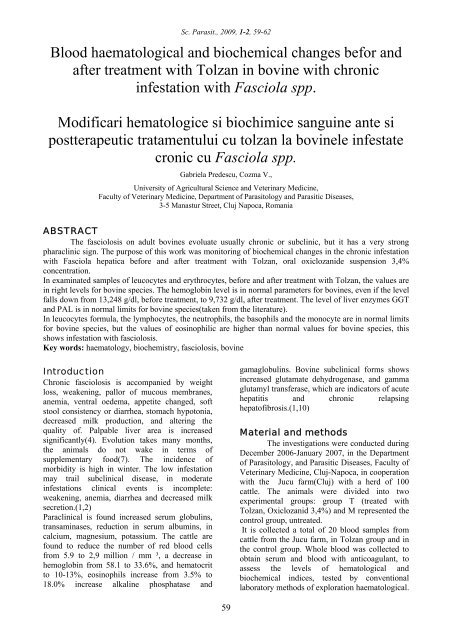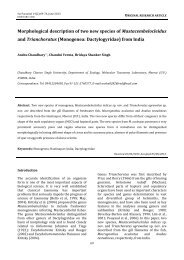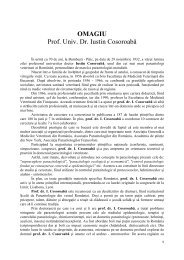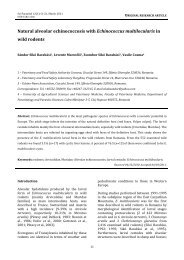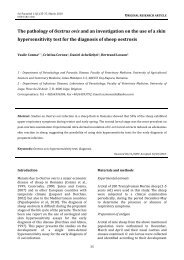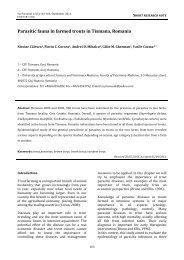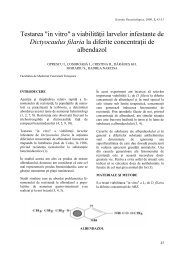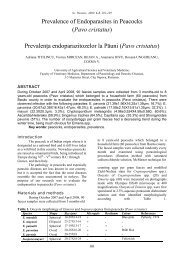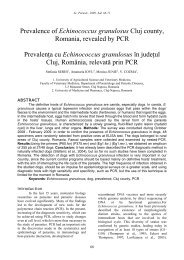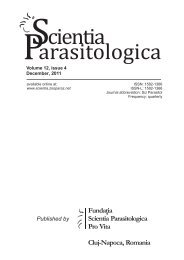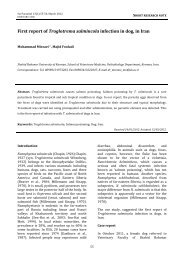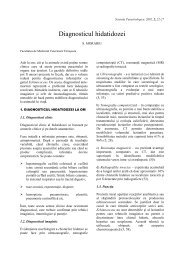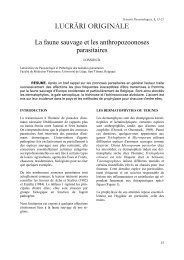Blood haematological and biochemical changes befor and after ...
Blood haematological and biochemical changes befor and after ...
Blood haematological and biochemical changes befor and after ...
You also want an ePaper? Increase the reach of your titles
YUMPU automatically turns print PDFs into web optimized ePapers that Google loves.
Sc. Parasit., 2009, 1-2, 59-62<strong>Blood</strong> <strong>haematological</strong> <strong>and</strong> <strong>biochemical</strong> <strong>changes</strong> <strong>befor</strong> <strong>and</strong><strong>after</strong> treatment with Tolzan in bovine with chronicinfestation with Fasciola spp.Modificari hematologice si biochimice sanguine ante sipostterapeutic tratamentului cu tolzan la bovinele infestatecronic cu Fasciola spp.Gabriela Predescu, Cozma V.,University of Agricultural Science <strong>and</strong> Veterinary Medicine,Faculty of Veterinary Medicine, Department of Parasitology <strong>and</strong> Parasitic Diseases,3-5 Manastur Street, Cluj Napoca, RomaniaABSTRACTThe fasciolosis on adult bovines evoluate usually chronic or subclinic, but it has a very strongpharaclinic sign. The purpose of this work was monitoring of <strong>biochemical</strong> <strong>changes</strong> in the chronic infestationwith Fasciola hepatica <strong>befor</strong>e <strong>and</strong> <strong>after</strong> treatment with Tolzan, oral oxiclozanide suspension 3,4%concentration.In examinated samples of leucocytes <strong>and</strong> erythrocytes, <strong>befor</strong>e <strong>and</strong> <strong>after</strong> treatment with Tolzan, the values arein right levels for bovine species. The hemoglobin level is in normal parameters for bovines, even if the levelfalls down from 13,248 g/dl, <strong>befor</strong>e treatment, to 9,732 g/dl, <strong>after</strong> treatment. The level of liver enzymes GGT<strong>and</strong> PAL is in normal limits for bovine species(taken from the literature).In leucocytes formula, the lymphocytes, the neutrophils, the basophils <strong>and</strong> the monocyte are in normal limitsfor bovine species, but the values of eosinophilic are higher than normal values for bovine species, thisshows infestation with fasciolosis.Key words: haematology, biochemistry, fasciolosis, bovineIntroductionChronic fasciolosis is accompanied by weightloss, weakening, pallor of mucous membranes,anemia, ventral oedema, appetite changed, softstool consistency or diarrhea, stomach hypotonia,decreased milk production, <strong>and</strong> altering thequality of. Palpable liver area is increasedsignificantly(4). Evolution takes many months,the animals do not wake in terms ofsupplementary food(7). The incidence ofmorbidity is high in winter. The low infestationmay trail subclinical disease, in moderateinfestations clinical events is incomplete:weakening, anemia, diarrhea <strong>and</strong> decreased milksecretion.(1,2)Paraclinical is found increased serum globulins,transaminases, reduction in serum albumins, incalcium, magnesium, potassium. The cattle arefound to reduce the number of red blood cellsfrom 5.9 to 2,9 million / mm ³, a decrease inhemoglobin from 58.1 to 33.6%, <strong>and</strong> hematocritto 10-13%, eosinophils increase from 3.5% to18.0% increase alkaline phosphatase <strong>and</strong>gamaglobulins. Bovine subclinical forms showsincreased glutamate dehydrogenase, <strong>and</strong> gammaglutamyl transferase, which are indicators of acutehepatitis <strong>and</strong> chronic relapsinghepatofibrosis.(1,10)Material <strong>and</strong> methodsThe investigations were conducted duringDecember 2006-January 2007, in the Departmentof Parasitology, <strong>and</strong> Parasitic Diseases, Faculty ofVeterinary Medicine, Cluj-Napoca, in cooperationwith the Jucu farm(Cluj) with a herd of 100cattle. The animals were divided into twoexperimental groups: group T (treated withTolzan, Oxiclozanid 3,4%) <strong>and</strong> M represented thecontrol group, untreated.It is collected a total of 20 blood samples fromcattle from the Jucu farm, in Tolzan group <strong>and</strong> inthe control group. Whole blood was collected toobtain serum <strong>and</strong> blood with anticoagulant, toassess the levels of hematological <strong>and</strong><strong>biochemical</strong> indices, tested by conventionallaboratory methods of exploration <strong>haematological</strong>.59
Sc. Parasit., 2009, 1-2, 59-62To make the leucocytes formula it is used Dia-Quik-Panoptic color. For the evaluation of<strong>haematological</strong> indices determination oferythrocytes was done through Turbidity method,hemoglobin determination by colorimetricmethod, <strong>and</strong> determination of total leukocytes wasperformed using Turk solution. The methods ofliver exploration. The methods of liverexploration included the determination of γ-glutamyltransferase activity using one reagent,<strong>and</strong> determination of alkaline phosphatase activityusing amethod with a single reagent. The resultswere interpreted in statistical terms using theMicrosoft Office Exel 2007.Results <strong>and</strong> discussionTo reflect the paraclinics <strong>changes</strong> occurring inbovine fasciolosis were performed serological <strong>and</strong>blood tests <strong>befor</strong>e <strong>and</strong> post-therapeutic <strong>after</strong> usingTolzan- Oxiclozanid 3,4%. The results obtained inthe two experimental groups are presented inTable 1:Table 1 – <strong>Blood</strong> <strong>and</strong> serological laboratory values<strong>Blood</strong> ComponentsLeucocitary formula (%)Liver enzymes (U/l)The values recorded<strong>befor</strong>e treatmentThe values recordedpost-treatmentTotal leucocyte(thous<strong>and</strong>s/mm 3 )5335 5125Erythrocytes(million/mm 3 )7,556 4,669Hemoglobin(g/dl)13,248 9,732Lymphocytes 52,5 51,7Monocytes 4,5 1,9Eosinophils 16,7 13,5Neutrophil 24,8 29,3Basophils 0,1 0,2GGT 28,3 14,5PAL 96 76Following laboratory tests in group T <strong>befor</strong>etherapy total leukocyte values were5335(thous<strong>and</strong>s/mm 3 ) <strong>and</strong> post-therapy are5125(thous<strong>and</strong>s/mm 3 ). Values fall within thenormal bovine species(6), <strong>and</strong> <strong>befor</strong>e treatment<strong>and</strong> <strong>after</strong> treatment differences obtained in groupT are not statistically significant(p>0,05).Erythrocyte values also were within normal limits(4,5). Pre therapeutic in T group values were7.556 million/mm³, <strong>and</strong> <strong>after</strong> treatment were 4.669million/mm³. Erythrocytes value are normal forbovine species(5,6). Differences between group T<strong>befor</strong>e <strong>and</strong> <strong>after</strong> treatment are distinct statisticallysignificant (p
Sc. Parasit., 2009, 1-2, 59-62eosinophils in T group were 13.6 ± 8.708% <strong>and</strong><strong>after</strong> treatment were 13.5±6.974%. Increasednumber of eosinophils is actually an intolerancereaction of animal body, to the substancesdistributed through the parasites. It is noted thatlike the production of antibodies,hypereosinophilic reaction appears depending byterms of parasite contact with host tissues <strong>and</strong>their amplitudes responded. In generaleosinophilia reach the highest level during theinvasion of the body then diminishing during thelatency period. Ghergariu <strong>and</strong> colab.,2000,describe that eosinophilia is recorded forparasitism associated with hypersensitivityinduced by parasitic infestation. Antiparasiticmechanisms of eosinophilia place under theinfluence of signals from the extracellularenvironment. Eosinophils are mobilized <strong>and</strong>undergo transformation that increase performancefrom all points of view to be able to causeremoval of various substances that have inducedactivation. Hendrix C.M., 2003 describe that thereare 3 main ways in which eosinophilia acts on theparasite.• the mechanism of cytotoxicity cell mediatedAntibody-dependent, in this case eosinophilsmay be linked the target covered by variousimmunoglobulins;• eosinophils may be linked with the targetscovered by the C3b fragment of complement,it exacerbates binding functions, causingdamages the parasite membrane;• the interaction between IgE <strong>and</strong> eosinophils toobtain specific mediators, resulting inparasitic defense in two ways: localaccumulation of neutrophils <strong>and</strong> otherleukocytes, leukocyte activation <strong>and</strong> increasedtheir activity to damage parasites, <strong>and</strong> lastwould be action in the local tissue elements,intermediate local inflammation <strong>and</strong>producing unfavorable conditions fordevelopment of parasites.Neutrophils <strong>and</strong> basophils values were withinnormal limits both pre <strong>and</strong> post therapeutic(4,5).Neutrophils number pre-therapeutic in the groupT were 24.8±9.097% <strong>and</strong> post-therapeutic29.3±11.602%(4,5). Differences between grouppre-treatment <strong>and</strong> post-treatment are statisticallyinsignificant (p>0.05). Neutrocitopenia is found inhepatosis, gastroenteritis, weaknesses.The values reported for the basophils pretherapeuticin the group T had value 0.1±0.3%<strong>and</strong> post-therapeutic 0.2±0.4%. Differencesbetween group pre-treatment <strong>and</strong> post-treatmentare statistically insignificant (p>0.05)GGT liver enzyme values in group T fall withinnormal limits for bovine species (8). Mean GGTvalue, <strong>befor</strong>e treatment are 23.8 U / L <strong>and</strong> <strong>after</strong>treatment 14, 5 U / L. Differences between antetreatment<strong>and</strong> post-treatment group arestatistically significantly different(p
Sc. Parasit., 2009, 1-2, 59-62Reference1. COZMA V., NEGREA O., GHERMANC., 2002. Diagnosticul bolilor parazitarela animale. Edit. Genesis, Cluj-Napoca,p.130-149.2. DALTON J.P., 2004. Fasciolosis, CABIPublishing, Dublin City University,p.191-201.3. DAWES B.HUGHES D.L., 1964.Fascioliasis:the invasive stages ofFasciola hepatica in mammalian hosts, p.97-160.4. DUNN A.M., 1978. Veterinaryhelmintology, Medical books, London, p.5-6.5. GHERGARIU S., POP A., KADAR L.,1985. Ghid de laborator clinic veterinar,Edit., Ceres, Bucureşti, p. 132-140.7. HENDRIX C.M., 2003. Diagnosticparasitology, Auburn University.8. KADAR L., 2002. Investigaţiibiochimice în Laborator Clinic Veterinar,Edit., AcademicPres, Cluj-Napoca.9. KANAY Z., KURT D., ELITOK B.,GUZEL C., DEULI O., 2001. Effects ofFasciola hepatica invazion on iron, cooper<strong>and</strong> zinc levelin liver <strong>and</strong> kidney oflambs, Veteriner Bilimbri Deregisi, p. 17-20.10. MARGARET W., RUSSELL L.,2001.Veterinary clinical parasitology, IowaState University Press.11. SZASZ G., 1996 Reaction rate methodfor GGT activity in serum, p. 120-128.6. GHERGARIU S., POP A.L., KADARL., SPÎNU M., 2000. Manual de laboratorclinic veterinary, Edit., All Medical,Bucureşti.62


